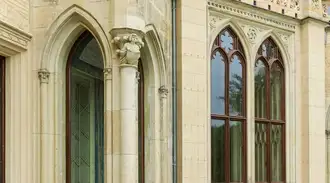
Babelsberg Palace
Key numbers
Background
Completed in 1849, the neo-gothic Babelsberg Palace was built as a summer residence for Prince Wilhelm of Prussia. It was made from the finest quality natural stone, terracotta and zinc castings, but it was the glass that really added the wow factor, with large-scale glazing offering stunning views of the natural park surroundings. However, subsequent decay and bomb damage during World War II was remedied with less appealing solutions such as transom bars and non-traditional materials such as float glass. Its former glory needed to be recaptured.
Challenge
The Prussian Palaces and Gardens Foundation Berlin-Brandenburg (SPSG), which owns the building, planned to use the Palace as a museum and drew up a masterplan to overhaul the palace and the park. SCHOTT’s challenge was to recapture the glazing’s original style while working with the diverse materials existing within the structure and adhering to strict conservation rules. The float glass installed over the years would need replacing with historically authentic glazing while maintaining 21st century energy requirements.Solution
After examining a number of samples, SPSG and their architects chose SCHOTT’s acclaimed restoration glass GOETHEGLAS for the project. As well as offering an irregular ‘wavy’ surface in keeping with the style of a 19th century palace, this robust, thermally toughened glass can be produced in large formats.
For the Palace windows, SCHOTT produced three-meter-long glass sheets, refined by thermal toughening and subsequent heat soaking tests. This enabled a large share of the all-glass windows to be installed. The 4.5-meter-high special formats were designed as laminated panes with butt joints. Insulating glass was also produced to address specific climate concerns, made with an outer pane of GOETHEGLAS and an inner pane of float glass.
19th century glass made with 21st century technology
SCHOTT GOETHEGLAS achieves a historically authentic look by using the Fourcault production process, which reproduces the irregular surface characteristic of window glasses from the 18th and 19th centuries. The process also enables modern features such as UV protection and thermal insulation to be incorporated, with the option of further processing into insulating, laminated, or tempered glass.Outstanding clarity for breathtaking views
The float glass previously used to restore Babelsberg Palace’s windows lacked the esthetic appeal of the original 19th century glazing and produced unwanted reflections. SCHOTT GOETHEGLAS delivers outstanding clarity, enhancing the breathtaking views over the park that so impressed 19th century visitors, while also retaining the irregular, eye-catching beauty of authentic historic glazing.Used materials & similar products
SCHOTT GOETHEGLAS combines the historically accurate irregular surface structure of windows found in buildings from the 18th and 19th centuries with modern-day functions. Those functions include thermal, solar, and UV insulation, as well as highly effective noise control. A variety of processing options also allows us to offer laminated, tempered, and insulated glass units.
Close collaboration for extensive approvals
For the Babelsberg Palace project, SCHOTT worked closely with SuP Ingenieure GmbH, a German civil engineering company, to examine the suitability of the glazing from a static perspective. While all SCHOTT restoration glass adheres to European technical standards that regulate the framework conditions and bending strengths, the work of SuP Ingenieure GmbH resulted in the windows meeting the strict safety requirements of ESG-H glazing and being granted extensive approvals from the building authorities.
Glass made by
SCHOTT
Glass Structural Engineers
SuP Ingenieure GmbH, Darmstadt
Architects
Dr. Krekeler Generalplaner GmbH, Berlin
Building owners
Prussian Palaces and Gardens Foundation Berlin-Brandenburg (SPSG)







